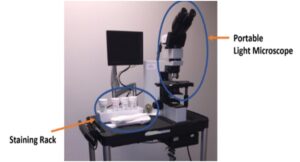Global Pathology Solutions Limited
+1-868-346-1463
globalpathologysolutions@gmail.com

FREQUENTLY ASKED QUESTIONS
RAPID ONSITE EVALUATION - R.O.S.E.
A. R.O.S.E stands for Rapid OnSite Evaluation
With R.O.S.E., the pathologist can immediately evaluate fine needle aspirations or even fine needle biopsies of a patient’s sample by doing cytologic preparations of these samples (literally smearing the cells on a slide!). Results are obtained within a few minutes. A decision can be then made by the clinical team on the next steps of intervention based on the results obtained.
A. All we need is a countertop and an electrical outlet. The example shows a portable light microscope (sometimes connected to a screen for telecytopathology) and a staining rack with both slides and our Diff quick (Romanowsky) stains for rapid staining of your samples.
A. R.O.S.E. can be performed during fine needle sampling of any lesion in the operating theatre, the endoscopy suite, the doctor’s office or in the interventional radiology suite.
After we receive the needle, we place a drop of the sample on the slide and smear it. After it air dries we then stain using minimal material, this is a manual process that takes at most 2 minutes.The pathologist will then read the sample after mounting and coverslipping.

A. A R.O.S.E. procedure can save you both time and money due to the literal and figurative costs of repeat samples.
We can then triage the specimen based on the pathologist’s call.If inadequate, additional samples can be taken, if lymphoma we can place in saline or RPMI for flow cytometry, if malignant we can place most of the specimen for cellblock preparation for immunohistochemistry and, if needed, we can give you a preliminary diagnosis so that you can get a head start on next steps for patient treatment.
A. R.O.S.E. has been performed for evaluation of transbronchial and percutaneous FNA lung samples, thyroid and pancreas lesions and lymph nodes (sentinel, suspiciousand for staging) in both the adult and paediatric populations.
When R.O.S.E. is used fewer passes for EBUS (Endoscopic ultrasound) FNA of endobronchial samples are required and it decreases the need for repeat FNAs of pancreatic samples.
FROZEN SECTION
A. The aim of this tissue freezing process is to provide a rapid diagnosis while the patient is on the operating table.
A. Cost containment
Up to 40% of breast resection cases are incompletely excised (with a positive margin). In institutions with routine frozen sections for breast margins, the rate of second surgeries is 3%.
Peace of mind
A frozen section can be performed if an unexpected lesion is found during surgery or if there is uncertainty whether or not the lesion of interest is completely excised.
Appropriate triage of specimens
Typically, surgical specimens are received in formalin. Tissue in formalin cannot be sent for flow cytometry, a critical ancillary test that is much needed for possible lymphoma cases. This will ultimately lead to a more accurate diagnosis as more ancillary testing can be performed.
A. First Frozen Section $1500.00 TTD
Subsequent Frozen Section from the same case $750.00 TTD

